
views
X
Research source
In fact, most cats will experience conjunctivitis at some point in their lives.[2]
X
Research source
If your cat has conjunctivitis, her eyes will probably look and feel very uncomfortable. Act promptly so she can get the treatment she needs to start feeling better.
Treating the Cause of Conjunctivitis
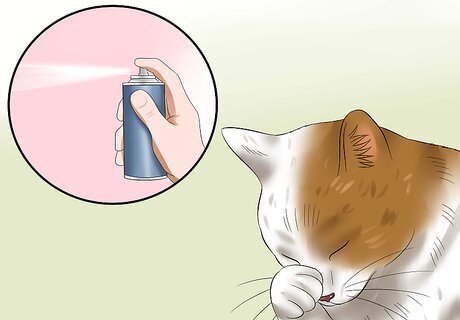
Identify the cause of conjunctivitis. Feline conjunctivitis is classified as either infectious or non-infectious. Causes of infectious conjunctivitis include viruses (feline herpesvirus, feline calicivirus), bacteria, and fungi. Examples of non-infectious causes are foreign objects (e.g., dust), airborne chemicals, and allergens. The most common infectious causes are feline herpesvirus, Chlamydia felis, and feline mycoplasma. Chlamydia and mycoplasma are types of bacteria. Taking your cat to your veterinarian will help you determine what is causing your cat’s conjunctivitis. If non-infectious agents are not the cause, your veterinarian will perform different diagnostic tests to identify the infectious agent.

Discuss treatment options with your veterinarian. Once your veterinarian has identified the cause of your cat’s conjunctivitis, they will recommend various treatment options. Discuss these options with your veterinarian. For general conjunctivitis (no specific cause), treatment usually consists of topical antibiotics and anti-inflammatory medications (e.g., hydrocortisone) that go in the affected eye. For feline herpesvirus conjunctivitis, treatments include topical antivirals, topical antibiotics, and oral interferon alpha (suppresses immune response to virus). Topical antibiotics for general or herpesvirus conjunctivitis treat bacterial infections that occur when the immune system becomes depressed after a viral infection. For bacterial conjunctivitis, topical antibiotics are used. Tetracycline works for Chlamydial infections. If a foreign body is stuck in your cat’s eye, your veterinarian may need to perform surgery to remove it. Topical eye treatments are available as drops or ointments.

Isolate your cat at home. If you have a multi-cat household, you will need to isolate the cat being treated. Infectious conjunctivitis can easily spread between cats, so you want to make sure your cat does not infect the other cats. Keep your cat isolated for the duration of the treatment.

Place eye drops or eye ointment into your cat’s affected eye. Eye drops are easier to administer than ointments, but need to be given frequently (3‒6 times/day). Eye ointments can be given less frequently than drops, but are more difficult to administer. If you are unsure how to give your cat the eye medications, have your veterinarian show you the technique before you leave the veterinary clinic. Your veterinarian will prescribe the number of eye drops (if applicable) and how often to administer the treatment. Before applying the eye drops or ointment, you may need to remove discharge around the eyes with a clean cotton ball and eyewash solution. Your veterinarian will recommend an eyewash solution for you. Eye drops will disperse quickly over the surface of the eye, so you will not need to rub the eye afterwards. For the ointment, you will spread a line of ointment across the eye. Since it is thick, you will need to close and gently massage the eyelid to make sure the ointment spreads across the eye.

Complete the full course of treatment. Your cat's eyes will probably looking better in a few days. However, do not stop treatment. This is especially important for infectious conjunctivitis—if you stop treatment early, the infectious agent may not be completely killed and may end up causing recurrent infection. It usually takes about 1 to 2 weeks before a cat’s eyes fully recover from conjunctivitis. Even if your cat’s eyes look better after just a few days, treating her for a week or more will ensure that her eyes fully recover. You may need to treat your cat for up to 3 weeks.
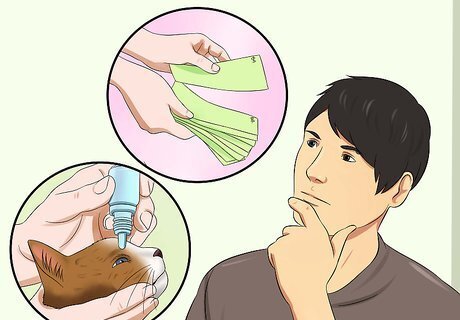
Learn about the challenges of treating viral conjunctivitis. Although treatments are available for feline viral conjunctivitis, there is no actual cure. This can make treatment for this form of conjunctivitis very frustrating and challenging. In addition, topical antiviral treatments tend to be very expensive and need to be given frequently. If your cat has viral conjunctivitis, be prepared for lifelong management of the condition, rather than a short-term cure.
Managing Recurrent Conjunctivitis
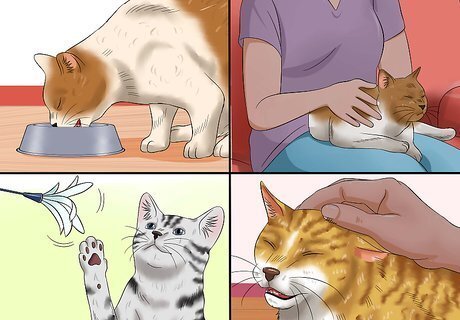
Reduce your cat’s stress levels. Since viral conjunctivitis is not curable, it can recur after initial treatment. These flare-ups are often caused by stress. Therefore, you should identify and remove potential stressors in your cat’s environment. For example, keep your cat’s daily routine as steady as possible. If you have multiple cats, make sure each cat has her own ‘supplies’ (e.g., food and water bowls, toys, litter box) to reduce bullying or fighting between cats. Your cat may also feel stressed if she becomes bored. Provide her with plenty of toys and rotate them on a regular basis. Puzzle toys are especially useful for keeping a cat busy and entertained.

Supplement your cat’s diet with oral lysine. Herpesvirus requires an amino acid called arginine to replicate. However, when the amino acid lysine is present, the virus will take up lysine instead of arginine, which will stop the virus from replicating. Your veterinarian can recommend a specific oral lysine supplement for your cat. Lysine can be used as a lifelong management option for feline herpesvirus conjunctivitis.

Consider vaccinating your cat. The severity of a herpesvirus conjunctivitis flare-up can be reduced with ocular (not injectable) vaccination. The vaccination works by strengthening the immune system and making the flare-up more bearable for your cat. Discuss this vaccination option with your veterinarian.
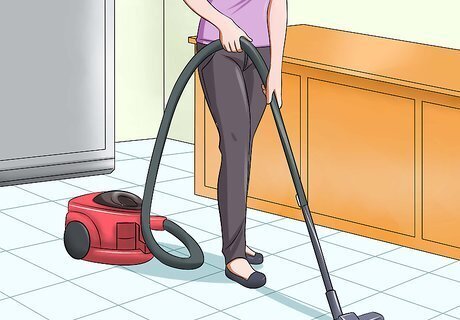
Minimize your cat’s exposure to allergens. If your cat’s allergies caused her conjunctivitis, then you should reduce her to exposure to the offending allergen as much as possible. For example, if she is allergic to dust, you will need to dust your home more frequently. If she is an outdoor cat, you may need to keep her indoors and away from outdoor allergens like pollen. If your cat's eyes became irritated when you used certain household cleaners, try keeping your cat away from the area where you are cleaning.
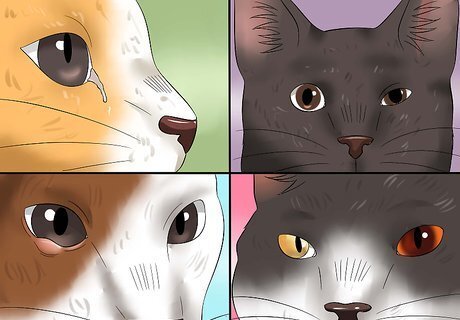
Look for signs of a flare-up. If your cat’s eyes start to look swollen and red, and you see colored discharge (e.g., green, yellow) coming from her eyes, your cat is likely experiencing a conjunctivitis flare-up. Other signs of a flare-up include increased tear production, squinting, and sensitivity to bright light. When your cat experiences a flare-up, contact your veterinarian about the best way to manage it.


















Comments
0 comment